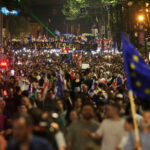Ukraine: Hundreds flee Kharkiv area after Russian cross-border attack
The head of the Kharkiv region has reported that nearly 1,800 individuals have been evacuated due to Russian assaults in northeast Ukraine.
Following Russia’s unexpected incursions on Friday, intense combat persists in the border region. Ukraine has anticipated a Russian offensive, possibly targeting Kharkiv, the nation’s second-largest city.
Nevertheless, Ukrainian authorities assert their readiness to repel any aggression.
On Saturday, Russia claimed to have captured five villages near Vovchansk in its latest offensive. However, the BBC has not independently verified this assertion.
The extent of Russian advancement remains uncertain, raising questions about whether this is a preliminary assault or the beginning of a larger campaign.
In response, Ukrainian artillery units are retaliating, their exchanges of fire reverberating through the already scarred streets.
According to Kharkiv regional head Oleh Syniehubov, a total of 1,775 individuals have been evacuated, while hundreds remain in Vovchansk, situated just 6km from the Russian border.
A resident named Serhii recounted the devastation caused by a Russian glide bomb, which destroyed his home and vehicles, injuring his wife.
Despite the danger, he hesitates to leave, concerned about the fate of their four goats. Amid the wreckage, the ominous sound of more glide bombs being released underscores the lethal impact of Russia’s air force, to which Ukraine currently lacks a viable response.
Although Ukrainian officials acknowledge Russia’s capacity to escalate tensions in border regions, they maintain that capturing Kharkiv itself is beyond Russia’s reach.
Reports indicate that Moscow aims to establish a 10km buffer zone for its Belgorod region in response to Ukrainian cross-border attacks.
In his address on Saturday night, Ukrainian President Volodymyr Zelensky stated that fighting persists in seven border villages, according to Reuters.
“Our defensive operations continue in the Kharkiv region”, he said, adding the situation in Donetsk “remains especially tense”.
On Friday, the US announced a new $400m (£319m; €371m) military aid package for Ukraine.
It will be Washington’s third instalment of aid to the country after months of political deadlock – adding to the previous package worth a total of $7bn sent in late April.
US Secretary of State Anthony Blinken said the “urgently needed” aid would include air defence munitions, artillery rounds, anti-tank weapons and armoured vehicles.
On Friday, National Security Spokesman John Kirby told reporters that Russia would “make further advances in the coming weeks to try and establish a buffer zone along the Ukrainian border”.
Moscow has been looking to capitalise on the delayed arrival of US weaponry by continuing to push forwards in the eastern Donetsk region.
The return of heavy fighting in the north-east further illustrates Russia’s growing ambitions.


